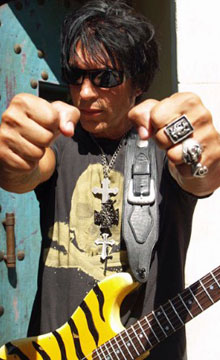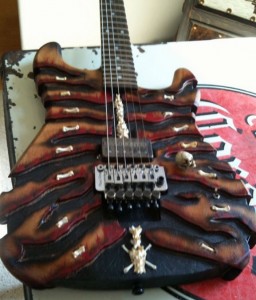George Lynch’s Woody Smoke & Mirrors Gear
Part 2 of 2; Plus George’s Vintage Parts Guitars
If you read part 1 of the Lynch Mob’s Smoke and Mirrors review, you know I’m digging the album. (I’m also really digging Lynch’s Souls of We disc – more on that in a future post.) But what’s odd about it, from a Lynch standpoint, is a surprising lack of gain in George’s tone.
Even though George is a gear nut, has piles of vintage gear, and lately seems to love vintage heads and speakers, he also loves high gain – and is a master of it. Throughout his career – from Dokken’s Tooth and Nail through his more-recent baritone playing – he has embraced gain. Not everywhere, not all the time, but overall he loves it.
And what’s great about it is that even with a baritone guitar and a high-gain amp, his tone is clear and distinctive. In other words, George’s use of gain is, to my ears, unique. He uses it his own way – none of that “mud” so prevalent in nu-metal crap.
So having said all that, back to Smoke and Mirrors, where his tone is more vintage-sounding than I’ve ever heard from George. Why? I couldn’t find an interview where he answers that question directly, but following is some pertinent info from sleazeroxx.com and guitarplayer.com (all quotes are George’s):
“My main rig is a combination of my Lynch Box [Randall signature head], a 100-watt head, with a couple of my modules: the Mr. Scary module and the Grail module – and I’m constantly working on that head. I’m doing different things – swapping out tubes, changing the bias, things like that. I’m constantly fiddling with my modules. That goes through a Lynch Box cabinet that I’ve got loaded with Super V speakers [modeled after the old Fane speakers he likes]. And then a lot of times I’ll either hook that up with my Soldano – which is the sixth Soldano ever made, it’s the one I used for the Wicked Sensation record – through an old HiWatt cabinet [with Fanes], and/or my ’68 [Marshall] Plexi through an old basketweave Marshall cabinet [a 4×12 presumably with 25-watt greenback Celestions].
“That’s my main rig that I use live or in the studio, doesn’t matter…. My Tiger is my go-to guitar for most everything. If I put that down, I’ll usually pick up my Super V [his latest ESP signature guitar], which I used for all the rhythms on…Smoke and Mirrors. For solos I used my Tiger or my 20th Anniversary Kamikaze or my ’59 Esquire, which is what really gives it the sparkle on top of the heaviness and the warmth of the Super V.”
[The Sleaze Roxx interviewer notes that George still sounds heavy on Smoke and Mirrors even with a comparatively clean sound.]
“…what you’re getting is, instead of oversaturation and front-end distortion…what you want to hear is the tone of the fingers and the strings and the wood, and if you have too much gain you lose all that. Now of course if you’re an ultra-heavy band and you just want to hit someone in the head with a ball-peen hammer or a sledgehammer, well then that’s a different thing, you know? When you tune down low, use heavy strings, get as much gain as you can…that’s great, but to me that’s sort of one-dimensional and un-dynamic. If you really want those subtle nuances that go from light to dark to heavy to clean and everything in between, and you want to have all that expression, different picking techniques and inflections of your playing, you need to have less gain to a certain extent.
“So I’ve been listening to a lot of country players, and other types of music, and fusion music, and jazz players, but especially country, and really listening to guys like Brad Paisley, and Albert Lee and guys like that, and learning from that I become more dynamic with my tone and signal path.”
George told Guitar Player this in May of this year:
“I’ve fallen in love with a lot of vintage gear [including a] ’59 Fender Esquire that’s just a desert-island guitar – it’s unbelievable. It does whatever you want it to. It’ll be Eddie on “Eruption” if you want it to, it’ll do Brad Paisley country— you name it. That guitar sort of led me into this restrained direction. Playing something that’s a little different from what I normally do is great. It’s an adventure.”
George also uses some cool, vintage-sounding effects on this album.
Notable: George Selling Vintage Parts!
A while back I noted that George is selling ESP guitars that he is customizing himself. They’re going for large dollars (naturally), but note that the stuff he’s doing to these guitars isn’t just cosmetic. Again from sleazeroxx.com:
“I have my own shop and spray booth at ESP, and I customize my signature ESPs and we also do stuff from the ground up. I surround myself with more proficient tradesman than myself, luthiers and metalworking people, and painters and stuff. I learn from them, but I do all the work myself.
“The last two guitars I’ve got on the table, I call them the Headhunters. One is a V, one is a Strat and I basically take the black sections of the [ESP] Tiger, I draw a different kind of tiger graphic on the body, and I want to get it back down to raw wood, and then I take a router and I just start routing between the stripes. Once I get it routed out, I start using Dremel tools and hand tools and I get it all just how I want it, and then I set the whole thing on fire (laughs). I burn out all these cavities, and then I start painting on it…. I’ve collected thousands of bones, bones from all over the place, big ones, little ones, everything. I go to a taxidermist actually and I learned a lot about the processes of hides and snakeskin and bones, and I apply all these kinds of elements to the guitar. So I route out cavities and I create kind of a rib and vertebrae effect on the guitar.
“[I] create the necks to my specific dimensions, quarter-sawn wide, flat maple necks. This one I have on the table right now I’m putting an old ’87 custom-wound Seymour Duncan Distortion pickup, taking it out of one of my guitars from my, I think, Aerosmith tour, and I’m putting that in the guitar and then I have a couple of old, very original Floyd Roses, the ones that he used to make in his shop, that he had built for Randy Hansen. They’re all high-grade steel, machined in his garage, got no fine tuners on them [but] they’re very rare and they sound great. It’s amazing. They’re not finished very well, but that’s the beauty of them….”
Wow! Those parts alone would be worth a small fortune.
Notable: Give the Album a Listen
This recently Tweeted by Seymour Duncan: “Hear the whole new Lynch Mob record Smoke and Mirrors for one whole week @ myspace.com/lynchmobrocks. All the tracks will be in the player.”
Category: ESP, Fane speakers, George Lynch, Hiwatt, Marshall, Randall Amplifiers, Telecaster















